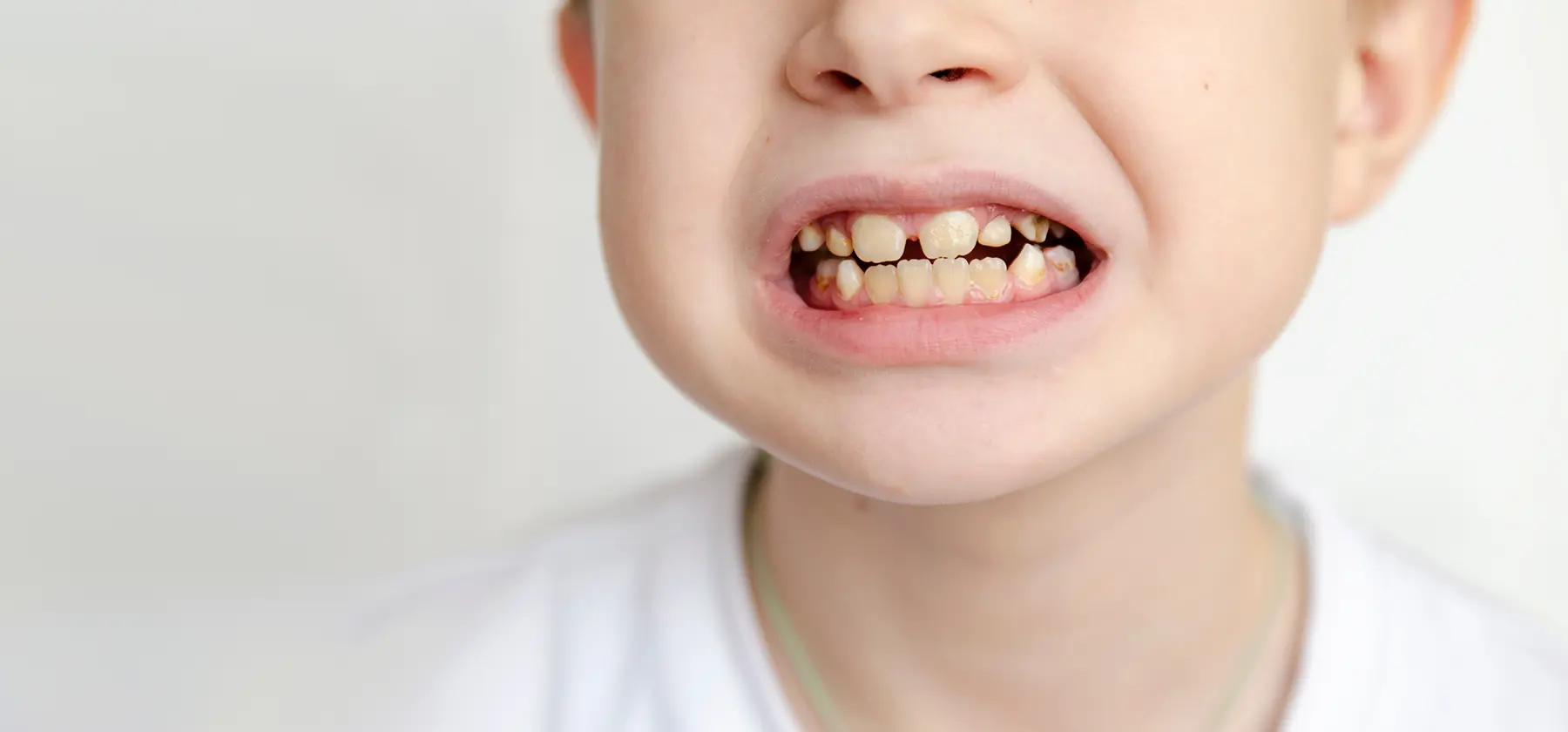
Are Your Kid’s Teeth Yellow? Here’s What Could Be Going On
Reviewed by Dr. Paul Rubin, DDS
Do your child’s teeth look yellow?
Yellow teeth are a common concern for parents, but in many cases, there’s no need to worry. Baby teeth are naturally whiter than adult teeth, so when permanent teeth start coming in, they may look more yellow by comparison.
But that’s not the only reason their teeth can appear discolored. Plaque buildup, diet, genetics, and even certain medications can all play a role.
In this blog, we will cover common reasons why your child’s teeth may look yellow, what’s normal, and when to be concerned. We will also share simple tips to help keep their smile healthy and bright.
Table of Contents
Key Takeaway
Yellow teeth in children can result from natural tooth development, dietary stains, plaque buildup, or genetic factors. Proactive oral hygiene and regular dental checkups can address most causes.
Common Causes of Yellow Teeth
Children’s teeth can develop a yellow or yellowish-brown color for many reasons. Let’s break down the most common factors.
Thinner Enamel & Natural Tooth Color
Baby teeth are naturally whiter than adult teeth.
When permanent teeth erupt, they may appear more yellow because their tooth enamel is slightly translucent, revealing the yellowish dentin underneath.
This intrinsic color difference is normal, but if the discoloration seems extreme, it could signal enamel hypoplasia (weak or thin enamel).
Poor Oral Hygiene Habits
Inadequate brushing allows plaque buildup—a sticky film of bacteria—to harden into calcified plaque (tartar), which has a yellow or brownish discoloration.
Plaque thrives on sugary foods, fruit juices, and carbohydrates, so consistent brushing and flossing are essential.
Dietary Stains
Pigmented foods like grape juice, berries, and tomato sauce, as well as acidic foods (citrus fruits, sports drinks) can erode enamel, making teeth look dull. Even healthy snacks like crunchy fruits can leave debris that contributes to surface stains if not cleaned properly.
Genetic Factors
Genetic conditions can affect enamel development or dentin color. For example, dentinogenesis imperfecta causes gray or yellowish-brown teeth. If your family has a history of yellowish dentin, your child may inherit it.
Medications & Medical Conditions
Certain types of antibiotics (like tetracycline) taken during pregnancy or early childhood can cause intrinsic staining. Metabolic disorders, congenital disorders, or tooth infections may also impact enamel formation.
How to Prevent & Treat Yellow Teeth in Kids
1. Improve oral hygiene routines: Use a kid-friendly fluoride or hydroxyapatite toothpaste and a soft-bristled toothbrush. Make brushing a fun activity with timers, apps, or toothbrushes featuring their favorite character. Ensure they rinse their mouth with water after consuming staining or acidic foods to reduce surface stains.
2. Limit stain-causing foods & drinks: Reduce intake of fruit juices, sports drinks, and pigmented snacks. Swap sugary or acidic beverages with water or milk, and use straws to minimize contact with teeth. Crunchy fruits and vegetables, like apples and carrots, can help clean teeth naturally.
3. Visit your pediatric dentist regularly: Routine dental checkups every six months allow professionals to remove plaque buildup and address early signs of discoloration or decay. For stubborn stains, professional cleanings or treatments like dental bonding or teeth whitening may be recommended.
4. Address underlying issues: If genetic factors or enamel defects are contributing to yellowing, your dentist may suggest fluoride treatments, sealants, or other personalized treatment plans to strengthen enamel and improve appearance.
Schedule a Dental Checkup At Lonestar Kid’s Dentistry in McKinney
If your child’s teeth look yellow, a visit to the dentist can help you understand why and what to do next. Regular checkups, good brushing habits, and a healthy diet all play a role in keeping their smile bright.
Schedule a checkup at Lonestar Kids Dentistry today! Together, we will create a plan to keep your child’s grin bright and confident.
To book an appointment at our pediatric dental clinic in McKinney, TX, call (214) 436-5555 or visit us at 5323 W University Dr #100, McKinney, Texas.
FAQs about Yellow Teeth in Kids
Permanent teeth may appear more yellow compared to bright white baby teeth. Permanent teeth have a thicker layer of yellowish dentin beneath the enamel, and their outer enamel layer is slightly more translucent than baby teeth.
This can create an illusion of yellowness, especially when new adult teeth erupt next to whiter primary teeth. However, if the discoloration seems unusually dark or patchy, it could indicate enamel defects, such as enamel hypoplasia, or genetic factors affecting dentin.
Several factors can cause yellow teeth in teenagers:
Natural tooth color: Permanent teeth have more dentin (the layer beneath enamel), which has a natural yellow tint. If enamel is thin or worn down, teeth may appear more yellow.
Plaque buildup: Inconsistent brushing and flossing allow plaque to harden into tartar, which can give teeth a yellow or brownish color.
Diet: Dark-colored drinks like soda, tea, and sports drinks, as well as foods like berries and tomato sauce, can stain teeth over time.
Braces or aligners: Orthodontic treatments make it harder to clean teeth properly, leading to plaque and stains.
Smoking or vaping: Nicotine and other chemicals in tobacco products can stain teeth and weaken enamel.
Encouraging good oral hygiene, limiting stain-causing foods, and scheduling regular dental cleanings can help keep your teen’s smile bright and healthy.
Learn more about oral hygiene with braces in this blog: The Right Way to Brush with Braces: Tips for Kids and Teens.
